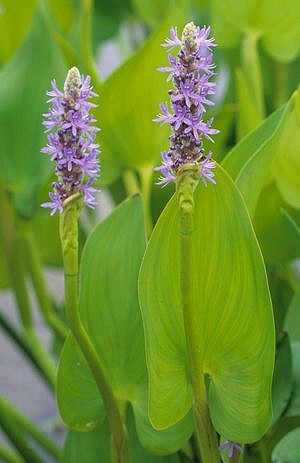
|
|
Pickerel
Weed ( Pontederia cordata)
|
Pickerel
Weed - Pontederia spp.
Pontederia is a genus of tristylous
hardy aquatic plants, commonly called the pickerel weeds. Pontederia is endemic to the
Americas, distributed from Canada to Argentina, where it is found in shallow water or on
mud. The genus was named by Linnaeus in honour of the Italian botanist Giulio
Pontedera.
Pontederia plants have large waxy
leaves, succulent stems and a thick pad of fibrous roots. The roots give rise to rhizomes that allow rapid colonization by vegetative
reproduction. Species are perennial, and produce a large spike of flowers in the
summer.
Pickerel Weed, has a creeping rhizome and
erect, glossy, dark green leaves that are slightly heart-shaped. In the
summer, racemes of violet-blue, funnel-shaped flowers are produced. This variety grows from 18 to 24 inches
high. Pontederia cordata (Pickerel Rush) is named for Giulio Pontedera, a Professor of Botany in Padua wholived from 1688 to 1757. Cordata means
heart-shaped. Pickerelweed receives its name from the pickerel fish, with which this plant is thought to
coexist.
P. lanceolata has narrower leaves and grows 4 to 5 feet in
height. It is a native of the southeastern U.S. and is therefore not as hardy as P.
cordata.
The flowers
of Pontederias are hermaphrodite (have both male and female organs) and are pollinated by
bees. There is a species of bee (Dufourea novae-angliae) that exclusively visits Pontederia
cordata; waterfowl also eat the fruit of the plant. Pickerelweed is a popular food source for
deer.
Pontederia cordata, and another member of the family, Eichhornia
crassipes, have become invasive in many tropical and temperate parts of the
globe, but are, on the other hand, efficient biological filters of polluted
water in constructed wetlands.
Pickerelweed is a moderately short, robust aquatic herb. The basal leaves extend from the submerged base above
water. They are large, glossy green and heart-shaped.
The radially symmetrical flowers are small and tubular with a funnel-shaped corolla that measures 8
mm. in length. The shallow corolla opens into three portions: an upper,
three-lobed lip, a middle lobe bearing two yellow spots, and a lower portion comprising of three separated
lobes. The corolla surrounds three long stamens and three short stamens and is supported by two
bracts: and upper, sheath-like bract and a lower, short, leaf-like bract.
The fruit is small and seed-like.
Pickerelweed is an edible
plant. The leaves can be eaten as greens and the seeds can be roasted and eaten as
nuts. Seeds can be eaten raw, cooked like rice or dried and ground into a
powder. A very acceptable nutty flavour and texture when raw, they are said to be excellent if the seed is lightly roasted in an
oven. Young leafstalks can be eaten raw or cooked. The whole plant is edible cooked or
raw. It can be added to salads, cooked like spinach or added to soups.
An infusion of the plant has been used as a contraceptive.
Source:
http://en.wikipedia.org/wiki/Pontederia
http://www.botany.com/pontederia.html
http://www.bio.brandeis.edu/fieldbio/Wildflowers_Kimonis_Kramer/
PAGES/PICKERELWEED_PAGE_FINAL.html
http://www.pfaf.org/database/plants.php?Pontederia+cordata
